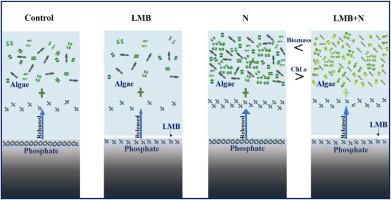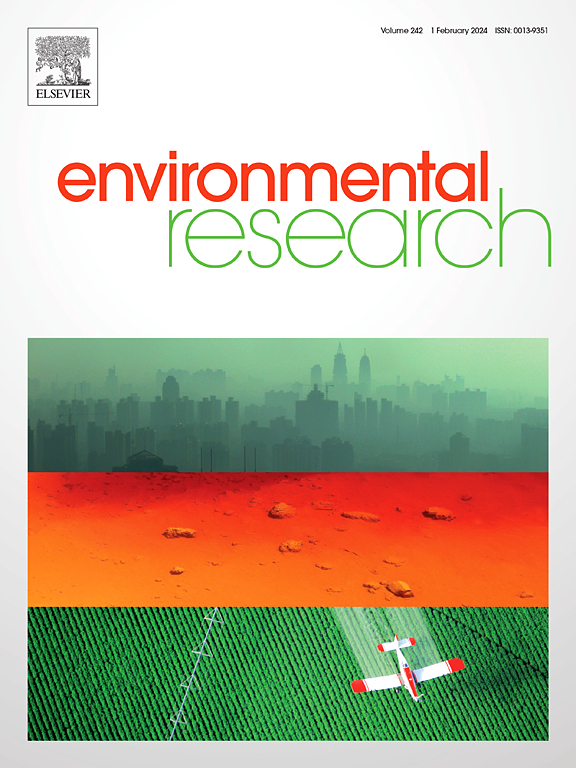外部氮涌入阻碍了镧改性膨润土(LMB)在浅水湖泊中控制磷和藻类的功效。
IF 7.7
2区 环境科学与生态学
Q1 ENVIRONMENTAL SCIENCES
引用次数: 0
摘要
在湖泊和其他水体的富营养化管理中,调节内部和外部的磷(P)占主导地位,而由于固氮蓝藻的存在,对氮(N)的控制则不太重视。然而,外部氮涌入可能会刺激非 N2 固定蓝藻的增殖,从而在夏季促进蓝藻藻华。为了阐明氮调节的意义,我们进行了一项双因素正交实验,研究外部氮输入对沉积物固碳材料镧改性膨润土(LMB)功效的影响。实验结束时,LMB+N 处理的总悬浮固体(TSS)、有机悬浮固体(OSS)浓度和光衰减系数(Kd)分别是 LMB 处理的 7.34 倍、8.65 倍和 5.20 倍。LMB+N 处理的总氮(TN)、总磷(TP)和可溶性活性磷(SRP)浓度分别是 LMB 处理的 3.02 倍、1.30 倍和 0.60 倍。然而,与氮处理相比,LMB+N 处理中的 TP 和 SRP 分别降低了 46.98% 和 54.93%。LMB+N 处理中藻类的叶绿素 a(Chl a)浓度是 LMB 处理的 2.86 倍,比 N 处理低 17.13%。在 LMB+N 处理和 N 处理中,蓝藻生物量占藻类生物量的 95% 以上。此外,与 LMB+N 处理相比,N 处理中藻类的光合性能明显提高。我们的研究结果表明,外部氮涌入大大降低了 LMB 控制磷和藻类的效果。因此,实施更严格的氮控制政策对富营养化控制具有重要意义。本文章由计算机程序翻译,如有差异,请以英文原文为准。

External nitrogen influxes hinder the efficacy of lanthanum-modified bentonite (LMB) on phosphorus and algae control in shallow lakes
Regulating internal and external phosphorus (P) holds a predominant position in eutrophication management of lakes and other water bodies, with less emphasis on controlling nitrogen (N) due to the presence of N2-fixing cyanobacteria. Nonetheless, external N influxes may stimulate the proliferation of non-N2-fixing cyanobacteria, thereby fostering cyanobacteria blooms during summer seasons. To elucidate the significance of N regulation, a two-factor orthogonal experiment was performed to study the influences of external N input on the efficacy of lanthanum-modified bentonite (LMB), a sediment capping material for P immobilization. At the experimentation ends, the total suspended solids (TSS), organic suspended solids (OSS) concentrations and optical attenuation coefficient (Kd) in the LMB + N treatment were 7.34, 8.65 and 5.20 times higher, respectively, compared to the LMB treatment. The total nitrogen (TN), total phosphorus (TP) and soluble reactive phosphorus (SRP) concentrations in the LMB + N treatment were 3.02, 1.30 and 0.60 times higher, respectively, than those in the LMB treatment. However, TP and SRP in the LMB + N treatment were 46.98% and 54.93% lower, respectively, compared to N treatment. The chlorophyll a (Chl a) concentration of algae in the LMB + N treatment was observed to be 2.86 times higher compared to the LMB treatment, and 17.13% lower compared to the N treatment. The biomass of cyanobacteria accounted for more than 95% of algae in the LMB + N treatment and N treatment. Furthermore, the photosynthetic performance of algae in the N treatment increased significantly, compared to the LMB + N treatment. Our results indicated that external N influxes significantly reduce the efficacy of LMB to control P and algae. Thus, the implementation of more stringent N control policies holds great significance in the eutrophication control.
求助全文
通过发布文献求助,成功后即可免费获取论文全文。
去求助
来源期刊

Environmental Research
环境科学-公共卫生、环境卫生与职业卫生
CiteScore
12.60
自引率
8.40%
发文量
2480
审稿时长
4.7 months
期刊介绍:
The Environmental Research journal presents a broad range of interdisciplinary research, focused on addressing worldwide environmental concerns and featuring innovative findings. Our publication strives to explore relevant anthropogenic issues across various environmental sectors, showcasing practical applications in real-life settings.
 求助内容:
求助内容: 应助结果提醒方式:
应助结果提醒方式:


